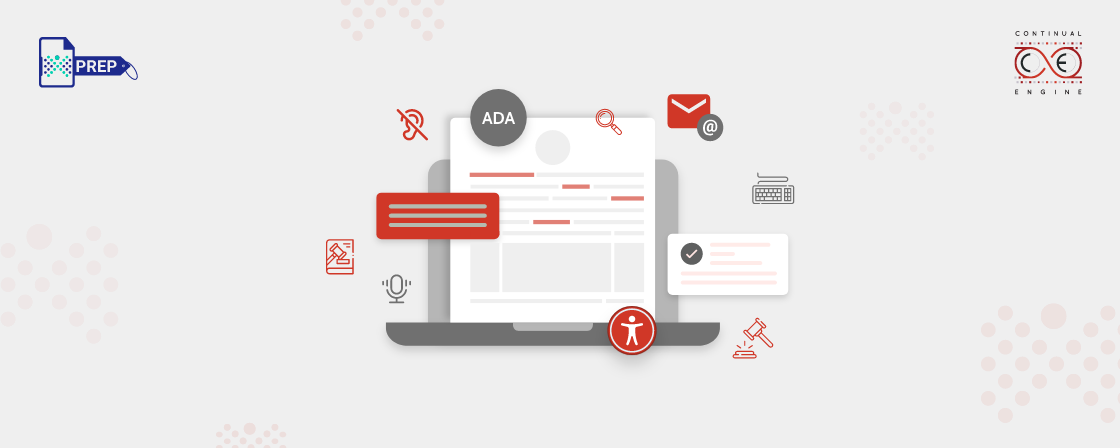Key Takeaways
- Americans with Disabilities Act (ADA) compliance in the workplace is necessary for an inclusive work environment.
- Building toward an accessible and ADA-compliant workplace includes:
- Evaluating your physical and digital space
- Consistently improving digital accessibility
- Offering accessibility tools
- Following WCAG 2.1 as a standard for web accessibility.
- Digital accessibility is required for employees and potential job seekers.
A Quick Look at ADA Compliance in the Workplace
To create a discrimination-free environment for employees and customers, accessibility in the workplace has become a requirement from every stance.
According to the CDC, around 26 percent of adults in the U.S live with a disability. People with disabilities are guaranteed equal opportunity and accessibility through the Americans with Disabilities Act (ADA), which includes state and local government services, employment, and even public digital communication like websites and applications.
While ADA requirements have existed for two decades, employment rates for people with disabilities are still low.
Building an ADA-compliant workplace can be challenging, especially when many employers are still unclear on how to comply with strict requirements. This article discusses how to start working on ADA compliance in the workplace:
Define the Evaluation Scope
Start with an initial evaluation of your workplace by drawing up components that you can measure accessibility.
The assessment can help you identify the currently available accessibility features and potential issues to determine where you need to improve to ensure ADA compliance in the workplace.
Physical Workplace Older infrastructural styles can be barriers to people with disabilities. Analyze your surroundings for obstacles that can hinder disabled people in doing their jobs. Your evaluation scope should include:
- Parking spaces
- Entryways
- Doorways and hallways
- Elevators
- Office spaces
- Restrooms
- Signage
Digital Workplace Modern spaces depend on technology. So, your digital workplace should be accessible too. Evaluating your digital communication and internal tools can help you identify where you lack web accessibility, such as in:
- Software
- Operating systems
- Telecommunication
- Multimedia products
- Electronics
- Presence of assistive technologies such as screen readers, keyboard navigation, and more.
Section 508 of the Rehabilitation Act oversees accessibility by government organizations, and it is also applied to private companies. Businesses that comply with ADA requirements in the workplace also avoid legal trouble.
Improve Digital Accessibility
Most websites, PDFs & documents, and applications are created without accessibility. Lack of accessibility means additional steps must be taken to make the content accessible to all.
As a business, you must ensure that your digital resources are up-to-date and accessible to current and potential employees. Employers must ensure that people with disabilities can apply for jobs and get information about salary, benefits, and other information on their websites. You can also increase digital accessibility by providing simple site navigation, text transcripts for video content, and alt tags for visual and audio files, among other options.
Provide Accessibility Tools
Along with assistive technology, accessibility tools also significantly promote ADA compliance in the workplace. It helps people with disabilities access and use websites, documents, applications, and other digital content like everyone else. These tools may be standalone products with built-in assistive technology or plug-ins such as screen readers and text readers, live call transcription and closed captioning, and Microsoft 10.
Accessibility tools can also benefit others, especially those with temporary disabilities, slow Internet connections or bandwidth, and even older users. As an organization, your responsibility is to provide your employees with the best document accessibility tools to help them perform their daily duties at the workplace; this can improve employee retention.
Follow the Web Content Accessibility Rules
Understanding that digital accessibility benefits your employees and consumers is crucial for your business. Your digital content must meet the latest Web Content Accessibility Guidelines (WCAG). To ensure all web content is perceivable, operable, understandable, and robust, the WCAG is a set of guidelines that overlooks the technical requirements for accessibility. Familiarizing yourself with these guidelines can make it easier to review your online resources for accessibility barriers. You can also choose accessibility experts who can evaluate your digital workplace to ensure they are consistent with WCAG 2.1 and ADA compliance. Not complying with the WCAG can incur discrimination lawsuits, hefty fines, and a negative public image.
Final Thoughts
- ADA compliance in the workplace strives to eliminate discrimination against people with disabilities by creating an inclusive work environment.
- First, define the evaluation scope of your physical and digital workspace to identify barriers and potential issues to work on remediation.
- Ensure your digital resources, such as websites, documents, job listings, and other information, are accessible to disabled employees and prospects.
- Providing your employees with accessibility tools can help them perform their duties at the workplace.
- Following the latest WCAG version is beneficial to employees and customers.
